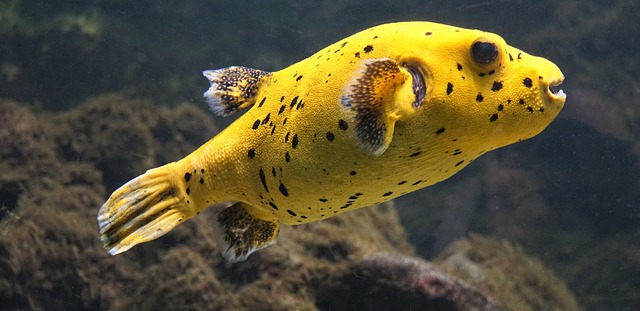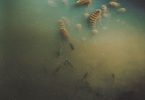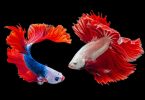Table of Contents
Raising freshwater puffer fish can be challenging to maintain but it is quite profitable for aquarists who are experienced.
More so, this species of fishes have a variety of sizes and colours, they have different techniques for hunting are very beautiful to behold. They are also known for the toxic elements that they have which are called tetrodotoxin.
However, do not worry because the species do not have the ability to produce these toxic elements themselves, so there is no danger in harbouring them.
Here is what you should know about their habitat, tank, and diet, as well as how to take good care of them.
Behavior
Although they are physically attractive, and ironically they are very aggressive and are usually territorial, when it is time to breed.
Freshwater puffer fish can immerse themselves in water when they are stressed or frightened in some other way. These species are fierce predators that have various techniques for hunting preys.
-
The Open Water Technique
The South American puffer and the Golden puffer usually swim through the rocks and the ground to get a prey, they even swim across oysters and plants to get little crustaceans and feed on snails. Stealthy Hunters
These species like to be hidden, and are usually in the banks of rivers and are always in hidden places.
-
Ambush Hunting
These hunters include the Congo puffers. They dig into the sand and lie in wait for the species of fish then they prey on them for food.
The terrible habit of most puffers is that they nip the fins of fishes, especially under the Chonerhinos and the Auriglobus.
There also is another different behaviour that has been noticed in different species, it is about how they can splash water or blow water on the substrate to discover a prey.
This species are also recognized for spewing water on the surfaces to get extra food.
The natural habitat for freshwater puffer
Various puffers are mostly seen around parts of India, Bangladesh, across South East of Asia, and the South America amazon basin, in the Nile, Congo, and a whole lot of other African rivers.
However, some species happen in open waters but are mostly found around river banks among plants that are in tropical and temperate climates.
Requirements for Water for the Freshwater Puffers
Species of freshwater fishes are prone to ailments, and the only way to avoid them is by providing them with better environments.
They thrive in water that is between seven point zero to seven point six. PH and seventy-four degrees to seventy-eight degrees Fahrenheit in temperature.
The various restrictions of water like the currents and hardness depend on the habitats and the species itself. A varieties of these species can fit within any tank that has a low water current of dKH that is around eight to twelve.
The puffers are mostly sensitive to bad conditions of the water which could be caused by excessive ammonia, nitrite, and nitrate in the water, as they produce too many waste that a filter is good if it has 50% recommended water that is changed weekly.
It’s important you setup your tank with a system that has a unique lighting system and heaters, hence a double system of filter.
Care guide for a freshwater puffer
The species of freshwater fishes are basically scale less and are considered to be ectoparasites. Protozoa are the most random parasites and they live on skin, fins, and gills.
The Ich disease fondly caused by Ichthyophthirius multifiliis is another random freshwater parasite for the species. However, raising the temperature in the aquarium can easily destroy this disease.
More than anything, it is better safe than sorry, so preventing the disease is key. A few measures must be taken to prevent this and it includes cleaning up new objects or organisms before they are added to the water, also separating them for a while is important that way carriers of germs and diseases are eliminated.
More so, species of fishes without any scales, like the puffers require adequate attention before they are added to the aquarium because they lack a defense line.
Hence maintaining proper conditions to keep your water and tank clean are paramount. And investing in good system of filters help prevent the problems
Housing Requirements for Water Puffers
Basically, the species of freshwater fishes need a properly cultivated aquarium that has a lot of hiding spaces. The ambush predators prefer being in the soft substrates to hide and dig easily.
Meanwhile, the stealth predators need tanks that have roots planted in them, while the hunters of the open water usually require very open places for swimming with obstacles like rocks, bogwood, and vegetation.
The size of the aquarium depends on the species that will be kept, like the Dwarf Pea Puffers can be left in aquariums as little as five liters, and some species may require twenty liters or more for a fish.
There are other big species that don’t need the expected space based on their size because they do not move about a lot.
Freshwater Puffers tank mates
These fish are better kept alone. They are aggressive nippers and easily bored.
There are also some species that like to be in pairs like the golden puffers, dwarf, and redeye that can be paired like the Danios, Mekong, Mbu and Nile puffers and could be seen in different tank fishes.
Freshwater puffer diet
These species of puffers are omnivores although they prefer feeding on flesh or meat based foods, hence they feed on shellfish, crustaceans, snails and other species of fishes.
They will eat a lot of whatever is given to them in the tank, like the dried meat, raw meat and the frozen meat.
More so, larger puffers feed on little species of frozen fishes like the whitebait fish, and the lancet fish. They also feed on vegetables and foods based on plants for at least two times in a week.
Again, their dentition cannot be ignored as they grow through their span and you could feed them using substrate animals that are hard like the shellfish, snails, and crustaceans to assist them as they growth their teeth.
If their teeth is quite long, you may have to clip the teeth otherwise the fish may find it difficult to eat with such dentition. Also, remember that different sizes of the puffer fish, has various habits of feeding.
Breeding of freshwater puffer fish
Breeding puffers in captivity is very difficult, freshwater puffer fish are known to breed in captivity.
In many cases, fresh water fishes are usually very careful with their eggs yet their parents feed on them when they are hatched, and providing the fry with adequate food is not really easy because it is sensitive to the quality of water, but one could feed those species of brine shrimp.
11 Types of Freshwater Puffer Fish
1. Congo Puffer

As the name implies, Congo pufferfish is native to African rivers. They grow to about 6 inches in length and will spend most of their time buried in the sand at the bottom of your aquarium hiding from dangerous predators.
Many colors are available, including black, sand and red, and Congo will also change its color to the surrounding area other than blue.
They require a large tank and are very sensitive to nitrates, so the water needs to be filtered.
2. Dwarf puffer

Dwarf pufferfish is also known as Pea pufferfish and Pygmy pufferfish. It is one of the smallest pufferfish in the world and is seldom larger than an inch and a half.
This species is very popular with aquariums because of its bright colors and small size. It is much easier to find the right aquarium size and filter needed in Dwarf than many other species.
3. Fahaka Puffer
These fish are very aggressive, and only experienced breeders should try to have one of these species. You will need a tank at least 60 inches long with strong filtering skills, and you will also need to plant dense vegetation.
These fish are also known to bite your fingers while feeding which can cause a painful bite. They can grow to about 16 inches in length.
4. Golden Puffer
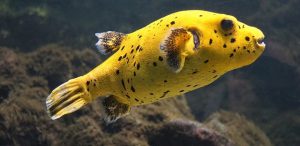
Golden Puffer comes in light black form. In the simplest version, the pufferfish has a white body filled with yellow dots. In the dark form, the black body has yellow spots. They have round bodies with small fins set at the back.
There is a teethlike projections on their skin like a type of sandpaper. When puffed up, these projections are more visible. There are some very large fish that can reach about 20 inches long when they are fully grown.
5. Imitator Puffer
Imitator puffer is also known as Dwarf Malabar Puffer, and is another type of small pufferfish. This fish is a bright yellow in color.
Males are lighter in color than females, and females have darker spots on their bodies. Although it is a small fish, they will still need an aquarium with at least 30 liters of water.
6. Mbu Puffer
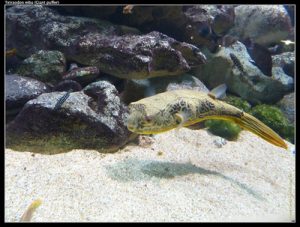
“Tetraodon mbu” by Joel Carnat is licensed under CC BY 2.0
Mbu Pufferfish is a very large species of pufferfish that can grow up to 26 inches) in length.
These fish are difficult to care for in the aquarium because it is difficult to supply enough space and filter to keep them healthy.
Therefore, we recommend this species only to experienced pufferfish keepers. MBU pufferfish have a unique pattern in their bodies that can change as they grow.
7. Ocellated Puffer
Ocellated pufferfish is one of the rarest species found. This species is a captive fish now taking over the rivers and streams of South Asia.
They are more peaceful than most other species and prefer to be kept in pairs.
You can also put them in a smaller aquarium than most others and it only requires 20 liters. However, you will still need a solid filtering system.
8. Red eye puffer
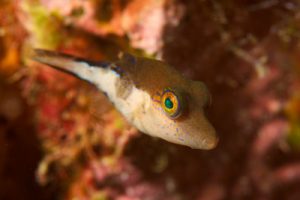
“Green Eyes” by laszlo-photo is licensed under CC BY 2.0
Red Eyed Puffer is a collection of four species of pufferfish all with red eyes. This type of pufferfish is known to be more aggressive than most and is very difficult to care for.
Because these fish are usually very aggressive, it is best to keep them in an aquarium alone without other pufferfish.
Although they rarely reach 2 inches, they need a larger tank because they produce more waste. We recommend an aquarium at least 32 inches tall. Many living, tall plants will also be needed.
9. Red-Tailed Dwarf Puffer
Red-Tailed Dwarf pufferfish is a small species that grows to about two inches in size. They prefer low-acid water and aquariums with many living plants.
The males in this species are much larger than the females, and have dark brown bodies with brightly colored stripes on its lower sides.
Young females have brown spots with a different shape and marking. Male and females have red eyes and red tail fins.
10. South American Puffer
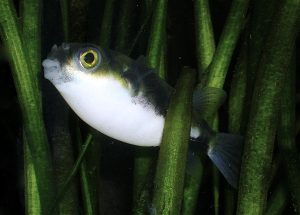
“File:Colomesus.jpg” by Neale Monks is licensed under CC BY-SA 3.0
The South American Puffer is one of the only pufferfish living in groups in the wild. In the aquarium, however, it is one of the most difficult fish to care for.
We only recommend skilled aquarists to buy this type, and yet, we only recommend getting one if you have a very large tank suitable for more than one. Well-maintained, it has attractive gold and black stripes.
The South American Puffer will need a rectangular tank at least 47 inches long. Water will need to be heavily filtered, and dense vegetation will need to be planted.
You will also need to give them hard food because their teeth are accustomed to growing, and you may still need to manually clip them.
11. Target Puffer
The Target Pufferfish grows to about six inches in length and needs a tank at least 35 inches in length to thrive. Strong filtration is required. Target pufferfish are nocturnal predators and are very active at night.
Summary
Pufferfish can be very rewarding if you are able to maintain a good environment for it to grow. Most puffers can be quite large, and the smaller ones have a different personality than most fish species.
It is always important to find a tank large enough with good filtration, so commitment is needed in advance as most of these fish live for more than five years.
We recommend one of the smaller species, such as the Dwarf Puffer, if you are new to pufferfish.

